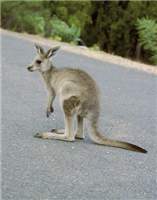Family
Macropodidae
Genus
Macropus
Species
giganteusThreats/Control Methods - Regional
Grey Kangaroos were taken off the threatened species list in 1995 and populations are being closely monitored and managed by Wildlife services in respective states. The species is well adapted to
Threats/Control Methods - Local
The irrigated fields and open spaces make
Local/Urban Actions
Since the species is very common in the ACT it is possible that you may come across a kangaroo that is suffering through lack of feed. Though this may appear concerning it is important to observe some basic rules, since kangaroos are wild animals. These are recommendations from the ACT Environment department: " Keep a safe distance of 30-50 meters. If you distress the animal, it could become aggressive. " Take note of where the animal was last seen and let your neighbours know, especially if they are dog owners. " Please make sure that dogs are on their leashes at all times, as is required by law. " Do not feed the kangaroos. Feeding wild animals creates a dependency relationship on humans, creating an artificial environment with ultimately negative consequences for the animals.
Common name/s
Eastern Grey Kangaroo, Great Grey Kangaroo, Forester, Scrub Kangaroo, Scrubber
Distinguishing Features
Eastern Grey Kangaroos have a small head with large ears. Their scientific name refers to their strong hind legs with massive feet. Their fur colouring is steel grey on the upper body with a lighter shade of grey on the tail and belly. The tail can be up to four feet long. Males can weigh between 50-80kg and females 25-35kg. They are different to other large Kangaroos in having a hairy muzzle, with fine hairs in the area between the nostrils and the upper lip.
Similar Species
There are 69 species of Kangaroo. The closest in appearance to the Grey Kangaroo is the Red Kangaroo (Macropus rufus), which is somewhat larger with rust-red colouring.
Distribution
The Grey Kangaroo lives where rainfall is greater than 250 millimetres a year, throughout eastern
Country of Origin
Australia
Survey Techniques
This species was identified visually during night searches and with scats.
Conservation (Pet/Pest) Status - National
Secure, not listed under the EPBC Act 1999. This species is protected and can only be taken with a licence issued by National Parks and Wildlife Services. Some farmers consider them a pest due to grazing competition with stock.
Conservation (Pet/Pest) Status - Regional
Protected species. Common
LSCCES Population
Protected species. Common
Associated vegetation community
Eastern Greys are mostly found in grasslands, woodlands and open forests, with scattered tree cover and a reliable water source. Grey Kangaroos can also be found on urban fringes where they take advantage of the abundance of irrigated grass in ovals, golf courses and urban parkland.
Limiting Resources
Eastern Grey Kangaroos are found in open areas, although compared to Red Kangaroos (Macropus rufus) they prefer denser scrubs and forests. Their diet depends readily available vegetation and some form of drinking water close by.
Breeding
Breeding occurs throughout the year with a peak of births in the summer. Kangaroos are marsupials and their young are born nedding to spend a considerable amount of time in their mother's pouch. The gestation period usually lasts 35 days. However, if the conditions in their surrounding environment are not ideal, females can delay the progress of the pregnancy so that birth occurs up to 12 months after mating. Joeys stay in the mothers pouch until they are mature enough to make trips outside and gradually these trips become lengthier. Complete weaning occurs after a period of 9 - 11 months. Young females can begin breeding the following year at two years of age. The life span for Grey Kangaroos is 8-12 years.
Behaviour
Unlike many other macropods, Eastern Greys are fairly social and spend a lot of time with their 'mob' (group) of up to twenty individuals. They are grazing animals, feeding on grasses in the early morning and in the evening. During the day they are mostly seen resting in the shade of trees and shrubs. Males may fight one another when competing for a female's attention. They are generally shy of humans and will hop away when approached.
Functional Group
Food Species
Members of the Kangaroo (Macropodidae) family are primarily grass and leaf eaters. They also eat shrubs and herbs. Their ability to convert dry grass into energy-giving glucose explains their success at living in so many parts of Australia.
Predators
Dingoes (Canis lupus), snakes and birds of prey will attack this species and kill the young. In some areas of Australia, humans cull Kangaroos for meat or to lower grazing pressure on agricultural properties.
References - (reader suitability of references, P=Primary teachers, S=Secondary students, T=Tertiary students and researchers)
Books:Strahan, R. 1983. The Australian Museum Complete Book of Australian Mammals. The National Photographic Index of Australian Wildlife. Angus and Robertson Publishers. Sydney. P, S, T
Online Publications:Environment ACT. 2006. Kangaroos in our Nature Parks and Reserves. [online]. Available at: http://www.environment.act.gov.au/petsandlocalwildlife/localwildlife/kangaroosinnaturereserves P, S, T
Tidemann, C., Roscoe, T. and Mitchell, B. 2006. Mammals of the Lower Sullivans Creek Catchment, Canberra ACT. Prepared for the Life in the Suburbs project using data from the Lower Sullivans Creek Catchment Ecological Survey (LSCCES). Australian National University. Canberra. [online]. Available at: http://www.lifeinthesuburbs.com.au/category.php?id=65 S, T
Environment Protection Agency and Queensland Parks and Wildlife service. 2007. Queensland Government. [online]. Available at: http://www.epa.qld.gov.au/nature_conservation/wildlife/native_animals/living_with_wildlife/kangaroos/. P, S, T
Researcher: Hedda Ranson-Elliott and Naomi Hogan

 Top
Top Top
Top